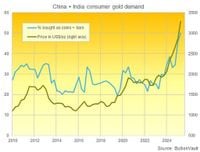The price of gold surged to new heights on October 20, 2025, trading at $4,316 per ounce as of 9:05 a.m. Eastern Time, according to multiple financial news outlets. This marks a $2 increase from the previous day and a staggering $1,597 jump compared to the same date last year, signaling gold’s robust performance amid ongoing global economic uncertainty. The precious metal’s meteoric rise—over 25% since the start of 2025—has been fueled by persistent inflation, a volatile stock market, and escalating geopolitical tensions, notably between the United States and China.
Ole Hansen, head of commodity strategy at Saxo Bank, told The Economic Times, “We’re holding well above $4,000 in gold and $50 in silver, and as long as we do that I do not expect any major amount of long liquidation coming into the market.” Hansen described the gold market as “still very bullish,” with the ongoing U.S. government shutdown providing underlying support to prices. The shutdown has also delayed key economic data releases, including the U.S. Consumer Price Index (CPI), which is now set for release on October 24 and is expected to show core inflation holding steady at 3.1% for September.
In addition to inflation, safe-haven demand has played a crucial role in gold’s ascent. Manav Modi, Senior Analyst at Motilal Oswal Financial Services Ltd, predicted that gold prices would likely trade range-bound during the Diwali week but acknowledged that “gold and silver continued to mark new all-time highs last week as well, only to lose strength on the last day.” Modi attributed this volatility to renewed U.S.-China trade tensions, deepening geopolitical uncertainties, and strong inflows into gold exchange-traded funds (ETFs).
Indeed, the trade dispute between the world’s two largest economies remains a central theme. U.S. President Donald Trump recently announced 100% tariffs on Chinese exports and new export controls on U.S. software, while China expanded its own rare earth export restrictions. However, Trump has since softened his stance, stating that such tariffs would not be sustainable and confirming plans to meet with Chinese President Xi Jinping in two weeks. This back-and-forth has left markets on edge, with safe-haven assets like gold and silver benefiting from the uncertainty.
Meanwhile, China’s economic growth slowed to its weakest pace in a year during the third quarter, even as stronger-than-expected data provided a temporary lift to global markets. Real estate investment in China fell by nearly 14%, and fixed-asset investment dropped slightly compared to last year, underscoring broader concerns about the health of the global economy. According to BullionVault, Shanghai gold prices dropped 2.6% from Friday’s finish, snapping a five-day streak of record highs, while in India, gold reserves crossed the $100 billion mark during the Dhanteras festival.
In India, the world’s largest gold consumer, the Diwali festival brought a shift in buying patterns. Soaring bullion prices led consumers to favor coins and bars over traditional jewelry, a trend confirmed by local wholesalers. “The ongoing price rally is boosting investor interest in gold, even as jewelry demand remains weak,” Reuters quoted a Mumbai wholesaler as saying. Domestic premiums surged, reflecting heightened volatility, though these eased slightly as the week progressed.
On the technical side, the spot gold price represents the immediate price for buying or selling gold in over-the-counter trades. This price is constantly in flux, influenced by investor demand, inflation expectations, and global events. When futures prices exceed spot prices—a condition known as contango—it typically signals high storage costs or bullish sentiment. Conversely, backwardation, where futures prices fall below spot, can indicate tight supply or immediate demand pressure. As of October 20, 2025, spot gold was up 0.3% at $4,259.84 per ounce, and U.S. gold futures for December delivery climbed 1.5% to $4,275 per ounce.
Other precious metals have also experienced significant price movements. Silver was trading at $53 per ounce, after crossing $52 on COMEX to set an all-time high amid acute global supply shortages and market tightness. Platinum stood at $1,623 per ounce, and palladium at $1,476 per ounce. Platinum’s gains—up nearly 80% year-to-date—are attributed to tight supply and strong industrial demand, while palladium’s price has been buoyed by trade actions against Russian imports and broader supply chain disruptions.
Despite these dramatic price increases, gold is not always a guaranteed win for investors. Historical data from 1971 to 2024 shows that while gold delivered an average annual return of 7.9%, the stock market outperformed with an average return of 10.7%. Still, during times of market turmoil, gold’s reputation as a store of value makes it an attractive option for risk-averse investors. Financial advisor James Taska explained, “There is a great debate as to whether paper gold is as useful as the physical. From a financial advisor’s viewpoint, it is much easier to rebalance a client’s allocation of gold if it is owned as an exchange-traded fund (ETF), and the spread when attempting to buy/sell gold can be quite variable and wide.”
There are several avenues for investing in gold, each with its own advantages and drawbacks. Physical gold can be purchased as bars, coins, or jewelry, though storage and security are concerns. ETFs and mutual funds offer more liquidity and ease of management, while gold IRAs provide a tax-advantaged way to include gold in retirement portfolios. Futures contracts allow speculation on future prices without handling the physical asset, though they carry their own risks.
Market experts remain divided on whether now is the optimal time to invest in gold. While the current environment of high inflation and geopolitical uncertainty has driven prices to record highs, some analysts caution that profit-taking and rapid swings are possible as tensions ease or as central banks adjust monetary policy. The U.S. Federal Reserve is widely expected to cut interest rates by a quarter percentage point at its policy meeting on October 28–29, with Fed Chair Powell indicating that future decisions will be data-dependent, especially in light of persistent labor market weakness and inflation risks. The International Monetary Fund (IMF) has raised its global growth forecast but warned of ongoing headwinds from the trade war.
Ultimately, gold’s appeal as a hedge against inflation and a portfolio diversifier remains strong. As the U.S. economy continues to experience volatility and global tensions simmer, many investors are turning to gold as a steadying force. Whether through physical holdings, ETFs, or other vehicles, gold’s role in the financial landscape appears secure—at least for now.
As Diwali’s lights fade and the market digests the latest economic data, all eyes remain on Washington, Beijing, and the world’s central banks. For those watching the price of gold, the only certainty is that uncertainty itself will keep this ancient asset glittering in the spotlight.





